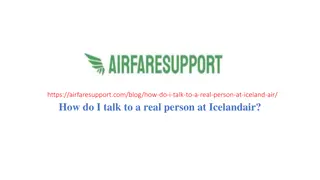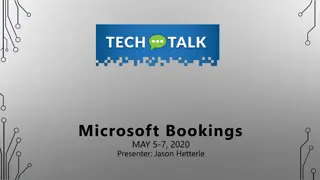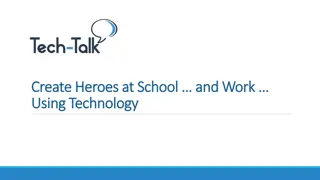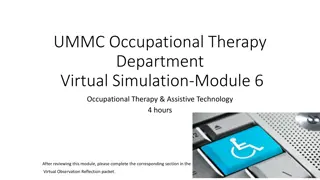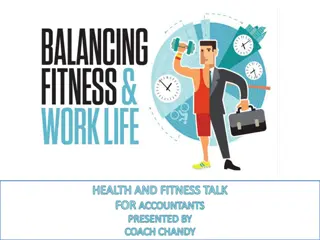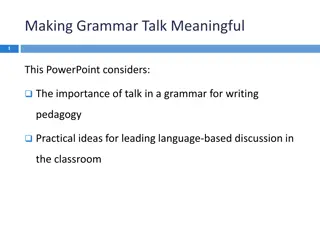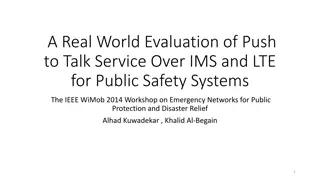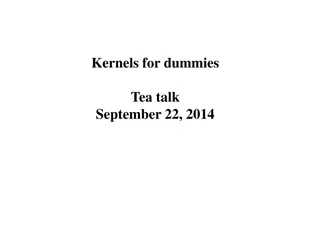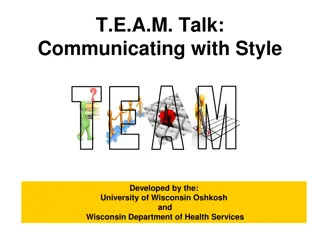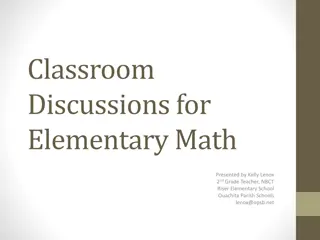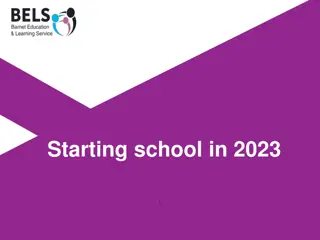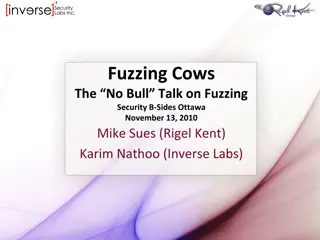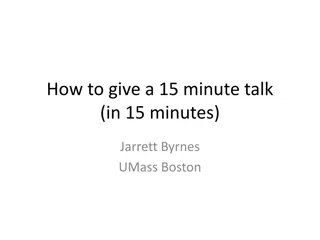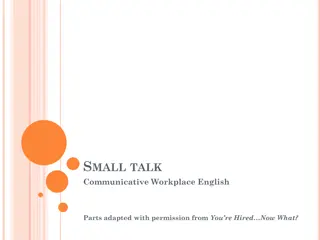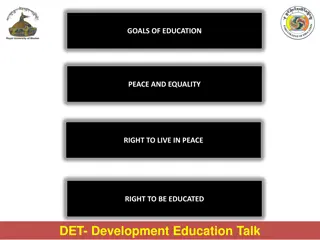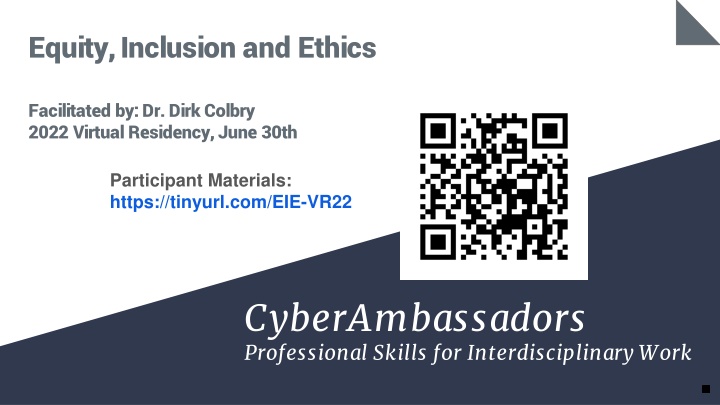
CyberAmbassadors Program Overview: Equity, Inclusion, and Ethics Residency
Join Dr. Dirk Colbry in the 2022 Virtual Residency focusing on Equity, Inclusion, and Ethics. Explore professional skills for interdisciplinary work with small group activities tailored to computing, engineering, science, or any field. The program was developed with contributions from various sources and is protected under a CC BY-NC-SA 4.0 International License. Discover the CyberAmbassador curriculum covering communication, problem-solving, teamwork, leadership, and more. Volunteer facilitators and STEM professionals are welcome to enhance their skills in this National Science Foundation-supported initiative.
Download Presentation

Please find below an Image/Link to download the presentation.
The content on the website is provided AS IS for your information and personal use only. It may not be sold, licensed, or shared on other websites without obtaining consent from the author. If you encounter any issues during the download, it is possible that the publisher has removed the file from their server.
You are allowed to download the files provided on this website for personal or commercial use, subject to the condition that they are used lawfully. All files are the property of their respective owners.
The content on the website is provided AS IS for your information and personal use only. It may not be sold, licensed, or shared on other websites without obtaining consent from the author.
E N D
Presentation Transcript
Equity, Inclusion and Ethics Facilitated by: Dr. Dirk Colbry 2022 Virtual Residency, June 30th Participant Materials: https://tinyurl.com/EIE-VR22 CyberAmbassadors Professional Skills for Interdisciplinary Work
Please Adjust your Screen Name Some small group activities have a disciplinary context Indicate your preference by adjusting your screen name C_ for Computing (for example, C_Katy Colbry) E_ for Engineering (for example, E_Katy Colbry) S_ for Science (for example, S_Katy Colbry) A_ for any if you do not have a specific preference (for example, A_Katy Colbry)
Acknowledgements The CyberAmbassadors program was developed by Katy Luchini-Colbry and Dirk Colbry, evaluated by Julie Rojewski and Astri Briliyanti, and appreciates the efforts of our many volunteer facilitators. Program materials are protected under a CC BY-NC-SA 4.0 International License. This material is based upon work supported by the National Science Foundation under Grant No. 1730137. Any opinions, findings, and conclusions or recommendations expressed in this material are those of the author(s) and do not necessarily reflect the views of the National Science Foundation. The CyberAmbassadors program was developed with contributions and feedback from many sources, including: Teaming Up includes substantial contributions from David Cribbs and Mark Luchini. Speaking Up is adapted and expanded from Effective Presentation Skills by Tau Beta Pi Engineering Futures. Leading the Change and Leading with Principles are informed by materials developed for the Entering Mentoring program and provided by cimerproject.org. Additional sources are noted throughout the materials. Graphics and images are original creations, part of Google apps, or free for commercial use without attribution from pixabay.com. For more information, please contact colbryka@msu.edu.
Agenda - Leadership Welcome and CyberAmbassadors Program Overview Leading the Change: Equity and Inclusion Leading with Principles: Ethics
CyberAmbassador Project National Science Foundation Grant (#1730137) Professional Skills for Interdisciplinary Work CyberInfrastructure (CI) Professionals STEM (science, technology, engineering, math) Volunteer Facilitators Training is provided Interest question on evaluation
The CyberAmbassador Curriculum FIRST CONTACT: Communicating with a Purpose LET S TALK: Communicating about Problems IT S COMPLICATED: Communicating About Complexity COMMUNICATION TEAMING UP: Effective Groups and Meetings SPEAKING UP: Effective Presentation Skills LEVELING UP: Problem Solving and Decision Making TEAMWORK LEADING THE TEAM: Understanding Style and Personality LEADING THE CHANGE: Equity and Inclusion LEADING WITH PRINCIPLES: Ethics LEADERSHIP
The CyberAmbassador Curriculum FIRST CONTACT: Communicating with a Purpose LET S TALK: Communicating about Problems IT S COMPLICATED: Communicating About Complexity COMMUNICATION TEAMING UP: Effective Groups and Meetings SPEAKING UP: Effective Presentation Skills LEVELING UP: Problem Solving and Decision Making TEAMWORK LEADING THE TEAM: Understanding Style and Personality LEADING THE CHANGE: Equity and Inclusion LEADING WITH PRINCIPLES: Ethics LEADERSHIP
Summer 2022 CyberAmbassador Trainings Virtual CyberAmbassador Certification Workshops 2-day Train-the-Trainers in-person Facilitation Workshops July 23-24, August 12-13, or August 18-19
Be Engaged Video on Email off Ground Rules Be Respectful Take lessons, leave stories Be Mindful Step Forward / Step Back Assume good intentions Take responsibility for impact Tool: Oops / Ouch
Chatter 1. Type your response into the chat window, but WAIT to hit enter 2. Listen for the countdown (three, two, one, CHAT!) 3. Hit enter and watch the responses scroll through the chat window!
Chatter Where in the world are you zooming from?
Agenda - Leadership Welcome and CyberAmbassadors Program Overview Leading the Change: Equity and Inclusion Leading with Principles: Ethics
Leading the Change Equity and Inclusion
Agenda Understanding Unconscious Bias Impact of Unconscious Bias Conscious Solutions and Strategies
Learning Goals Describe the source of unconscious or implicit assumptions, preconceptions, biases, and prejudices Increase understanding of the impact of unconscious bias in STEM Identify concrete strategies for learning about and addressing issues of equity and inclusion
Chatter What is an unconscious bias?
Blind spots: Challenge assumptions Learn more at PwC.com - http://www.pwc.com/us/en/index.jhtml Our brains are wired to make assumptions, which can sometimes be off base. We think it's an honest mistake; science calls it a blind spot. 2:20
What is Bias? a preference for (or against) a person, group or thing based on its characteristics https://diversity.ucsf.edu/programs-resources/training/unconscious-bias-training
Ethnicity Race Gender Identity Ability Religion What is Unconscious Bias? social stereotypes and preferences that form outside conscious thought Sexual orientation Weight Age Physical appearance https://diversity.ucsf.edu/programs-resources/training/unconscious-bias-training
Our Biased Brains https://en.wikipedia.org/wiki/Bias_blind_spot Survival Mechanism Rapid identification: what is that? Rapid categorization: will it harm us? Social Influence People like us are safer Others might harm us Traditions are familiar, comfortable New things might be dangerous Selective Inputs Ignore familiar information Make assumptions based on experience Frees brain to focus on new inputs
Common Unconscious Biases https://theewgroup.com/different-types-unconscious-bias/ Affinity / Like Me Bias preference for individuals who are like you in some way Confirmation Bias making decisions aligned with your experiences or beliefs Perception Bias relying on stereotypes and assumptions, instead of facts Anchor Bias centering on a particular fact, experience, or action Blind Spot Bias inability to recognize our own biases, even if we see bias in others
Agenda Understanding Unconscious Bias Impact of Unconscious Bias Conscious Solutions and Strategies
Recognizing Our Biases https://www.projectimplicit.net/resources/study-materials/ What unconscious biases do we have? How do our unconscious biases impact beliefs, behavior? Project Implicit Non-profit emerging from research at Harvard University Focus on understanding and interrupting implicit biases Online tests to help individuals understand our own biases Age, Gender, Nationality, Religion, Disability, Sexuality, Careers Results can be challenging, confusing, insightful
Recognizing the Impact https://serc.carleton.edu/sage2yc/musings/implicit_bias.html Research shows that unconscious bias are pervasive in STEM (Master, 2021) Negative impacts on participation and success of underrepresented populations Both majority and minority individuals exhibit bias These biases are often ingrained in childhood Unconscious biases impact experience and practice in STEM Men are often perceived as belonging in STEM, while women are not (Moss-Racusin et al. 2021) Unconscious biases about gender, weight, ability, race, etc. influence clinicians diagnosis and decision making skills and lead to disparities in healthcare outcomes (Gopal et al. 2021) Gender and race biases affect perceptions about competence and hireability (Eaton et al. 2020)
Example: Gendered Wording in Job Ads http://gender-decoder.katmatfield.com/; https://hbr.org/2018/05/the-different-words-we-use-to-describe-male-and-female-leaders Language is subtly gender-coded Different words are more commonly used as descriptors for men or women Result of social expectations and experiences The words used in a job advertisement matter Gender-coded language sends subtle messages Who is qualified? Who belongs in this role? Gendered wording impacts who applies Women are less likely to apply to jobs described in masculine terms Using feminine terms in job descriptions has little or no impact on men
Activity: Reviewing Job Advertisement Language Accept the breakout room invitation (write down the room number) The person whose first name comes FIRST alphabetically will be the timekeeper Review the different job descriptions Focus on the language describing the responsibilities and requirements Pay attention to the action or descriptive words that catch your attention Within your small group, discuss the job advertisements Which words feel masculine or feminine ? Why? What words might encourage or discourage applicants? Why? What changes, if any, might make these job ads appeal to a broader audience? At the end of the activity, return to the large group
Chatter What did you learn?
Results: Research Scientist Job Ads http://gender-decoder.katmatfield.com/ Research Scientist 1 Research Scientist 2 Research Scientist 3 Research Scientist 4 Masculine Feminine Masculine Feminine Overall Coding analyses analyze analytical competitive independently independent decision driven leading analyze Masculine-coded words in ad understand committed commitment collaborate enthusiastic collaborative support collaborate collaborative Feminine-coded words in ad
Agenda Understanding Unconscious Bias Impact of Unconscious Bias Conscious Solutions and Strategies
Bias-Busting Strategies https://www.youtube.com/watch?v=K-n7el87Dmo; https://doi.org/10.4300/JGME-D-21-00598.1 1. Identify and acknowledge your biases Project implicit (implicit.harvard.edu) 2. Identify your triggers Locations, tasks, individuals, groups, health, stress, hunger 3. Pause and slow down, in the moment Take 3 deep breaths, drink some water, review your notes 4. Make small, consistent changes in your behavior Ask for different opinions, eat lunch in a different seat, invite someone new to lead a meeting, standardize interview or review questions, check yourself for biases
Example: Strategies for Hiring https://doi.org/10.1016/j.jacr.2021.04.006 Train the hiring committee Review strategies for identifying and mitigating unconscious bias Increase the candidate pool Use targeted ads, outreach, and recruitment to reach diverse candidates Holistic review Consider broad experience and skills, not just conventional metrics (like GPA) Structured interviews Identify questions in advance and use them for all candidates
Learning Goals Describe the source of unconscious or implicit assumptions, preconceptions, biases, and prejudices Increase understanding of the impact of unconscious bias in STEM Identify concrete strategies for learning about and addressing issues of equity and inclusion
Agenda - Leadership Welcome and CyberAmbassadors Program Overview Leading the Change: Equity and Inclusion Leading with Principles: Ethics
Leading with Principles Ethics
Learning Goals Identify sources of ethical issues Become familiar with disciplinary codes of ethics Articulate ethical issues in research and practice Practice applying ethical decision making methods
Agenda Ethical Behaviors and Decisions Exploring Codes of Ethics
The $100 Question Someone walking along a sidewalk sees a $100 bill on the ground. They pick up the money, put it in their pocket, and walk away.
The $100 Question Someone walking along a sidewalk sees a $100 bill on the ground. They pick up the money, put it in their pocket, and walk away. Someone walking along a sidewalk sees a $100 bill on the ground. They look around and decides no one is watching. They pick up the money, put it in their pocket, and walk away.
The $100 Question Someone walking along a sidewalk sees a $100 bill on the ground. They pick up the money, put it in their pocket, and walk away. Someone walking along a sidewalk sees a $100 bill on the ground. They look around and decides no one is watching. They pick up the money, put it in their pocket, and walk away. Someone walking along a sidewalk sees a $100 bill fall out of a stranger s pocket. They pick up the money, put it in their pocket, and walk away.
Failure of Character https://www.ncbi.nlm.nih.gov/pmc/articles/PMC5592308/ Moral character is a combination of innate and learned habits Babies are naturally self-centered Children learn appropriate behavior from others Appropriate depends on cultural, familial expectations Character influences behavior Innate level of willingness to lie, cheat, steal, etc. Lessons learned from past experiences Understanding of current context, expectations
The Fast Food Dilemma A teenager interviewing for their first job, at a fast food restaurant, is asked to respond to this scenario: You see another employee giving free food to their friends. Would you ignore them, confront them, or talk to a manager? The teen says they would ignore it, because they don t know the situation. Maybe those people are hungry and don t have money, and they would never deny food to hungry people. They don t get the job.
Failure of Experience https://www.nap.edu/read/18519/chapter/4#10 Moral decision making requires knowledge What is expected? What is appropriate? How to get information or help? Moral decision making requires skill Thinking critically about a situation Understanding and synthesizing information Identifying potential actions and outcomes Ability to communicate effectively, under stress
Ethical Decision Making https://www.nap.edu/read/18519/chapter/4#10 Ethical decision making can be taught Key features of effective ethics instruction include: Knowledge: information about ethical issues and where to find help Skills: critical thinking, decision making, conflict resolution, teamwork Attitudes: open and willing to engage in ethical decision making Behavior: modeling effective communications, ethical conduct
Ethical Decision Making https://www.ethics.org/resources/free-toolkit/decision-making-model/ 1. Define the problem, and potential ethical issues 2. Get relevant information and assistance 3. Identify possible outcomes 4. Evaluate these alternatives, and identify ethical impacts 5. Make the decision 6. Implement the decision 7. Evaluate the decision; are ethical issues resolved?
Agenda Ethical Behaviors and Decisions Exploring Codes of Ethics
Codes of Ethics https://doi.org/10.1007/s10551-019-04192-x Address failure of knowledge, experience Describe ethical values, decision making guidelines Codes of Conduct are guides to ethical behavior in certain contexts Practical impact varies Professional licenses generally require ethical behavior In other situations, codes of ethics communicate expectations Provide a framework for discussion, enforcement
Disciplinary Codes of Ethics Computing: ACM Code of Ethics https://www.acm.org/code-of-ethics Engineering: NSPE Code of Ethics https://www.nspe.org/resources/ethics/code-ethics Science: World Economic Forum Code of Ethics for Scientists https://widgets.weforum.org/coe/index.html#principles
Code of Ethics Review Accept the breakout room invitation, 4-5 people per room Write down the room number, in case you need to rejoin later Review Code of Ethics (by discipline, in participant materials) Read the disciplinary case study aloud Discuss the questions after the case study
Chatter What did you learn?


